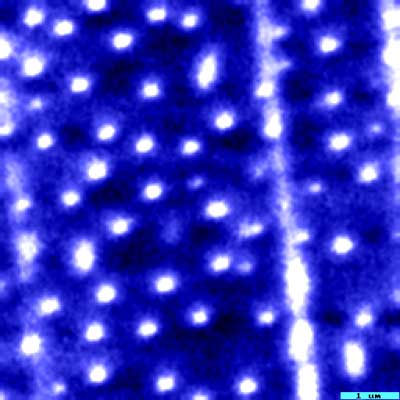MFM on Manganites and High-TC-Superconductors
We use magnetic force microscopy to investigate magnetic phenomena on the micro- and nanometer scale. Our research focuses on fundamental aspects in the fields of surface and interface magnetism as well as applications to new magnetic data storage devices. Currently, our most challenging scientific aim is the combination of MFM with the atomic resolution capability of atomic force microscopy (AFM) to perform exchange force microscopy, i.e., the detection of the exchange force between spins of individual surface atoms and a magetic atom at the tip end.
Navigate on our MFM web site with the buttons in the upper part or use the text links at the end of each page. Most images within this site can be enlarged by clicking on them. If you want to contact us, click on the Team button. The links on the left side will bring you to the other pages of the SPM-group.
Domain Growth on La0,7Ca0,3MnO3

The stability at low temperatures and the careful microscope design enable a detailed study of domain growth in external magnetic fields. The two images on the left show the maze type domain structure of an perovskite manganite thin film in two slightly different external magnetic fields. Bright areas indicate regions, where tip and sample magnetization is parallel (attractive magnetostatic interaction), while dark areas indicate an antiparallel configuration (repulsive magnetostatic interaction). It is difficult to detect any difference. However, after subtracting one image from the other, those areas, which changed their magnetization direction become clearly visible as dark spots in the right image.
Vortices in High Tc-Superconductors

Magnetic flux can penetrate type-II superconductors in the form of vortices, which contain one quantum flux. A vortex is normal conducting in the core and surrounded by screening currents. The magnetic field associated with a vortex can be detected by MFM.
In the MFM above image taken at 5.2 K vortices have been produced by field cooling of a BSCCO single crystal in an external field of 2 mT. They are imaged as bright spots. The flux is trapped in the superconductor at pinning sites. The radius of the vortices is in the order of the London penetration depth.
